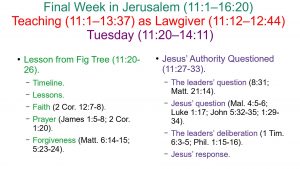Jesus’ Final Week in Jerusalem
Mark 11:1–16:20
Teaching (11:1–13:37)
King (11:1-11)
Sunday: Triumphal Entry (11:1-11).
Lawgiver (11:12–12:44)
Monday (11:12-19).
Tuesday (11:20–14:11).
 Lesson from Fig Tree (11:20-26).
Lesson from Fig Tree (11:20-26).Timeline.
As we begin the events that took place on Tuesday, there appears to be many things that happen on this day.
As we saw last week, Jesus began His role as Lawgiver on Monday.
Tuesday shows us many things that Jesus taught.
On this day, it would seem He also fulfills His role as Prophet in Ch. 13 and prepares for His role as sacrifice in Ch. 14.
In order to fit the traditional timeline of Jesus’ crucifixion on Friday, many will say that Wednesday was a “day of rest.”
Others will move up His crucifixion to have taken place on Thursday, defying the traditional timeline.
We’ll talk more about that later, but for now, we will be labeling this time period as Tuesday, and, to leave open the option for both views, the next day we will look at will be either Wednesday or Thursday.
As they passed by this withered fig tree, it was early in the morning. The Greek word suggests it was in the “fourth watch of the night,” meaning between 3 and 6 A.M.
I think that this was just before 6, which would make this just before dawn.
Lessons.
As I mentioned before, Jesus does not do anything (that’s recorded, at least) without a purpose or a lesson behind it.
Also as stated, one of the possible reasons that is not explicitly stated here could be showing an allegory of fruitless Jerusalem.
Due to their hypocrisy, faithlessness, and wickedness, they would soon wither away.
Jesus will be predicting these things and lamenting about them later in Mark 12 & 13, and especially in Matt. 23 & 24.
The problem was at the core, the very root of society there in Jerusalem, the reason why the fig tree was dried up from the roots—it was going to die and never come back.
There are lessons on three things that Jesus taught in light of these events: faith, prayer, and forgiveness.
Faith.
The first thing Jesus tells them after they see this withered fig tree? “Have faith in God.” Believe Him, trust in Him.
Here Jesus talks about the faith that can remove mountains!
Yet nowhere in the NT do we read of someone who did this.
This is a hyperbolic statement, basically saying that God is capable of doing the impossible.
Of course, God doesn’t bow to the whims and flights of fancy of any believer.
If I truly believe that He could make me fly, that doesn’t mean I will sprout wings and soar through the air.
Here is another passage that certain false teachers distort to say things like this: you weren’t healed because you didn’t believe hard enough.
It puts the onus on the believer rather than on God.
In truth, the onus is always on God. We must have faith that His will be done, regardless of the circumstances.
You weren’t healed because it wasn’t God’s will, and you might still have something to learn from it.
Paul’s thorn in the flesh, for instance, prevented him from being exalted above measure (2 Cor. 11:7). He prayed that it leave him, but that wasn’t God’s will.
Can anyone say Paul didn’t believe hard enough?
In any event, we should never doubt that God’s will will be accomplished.
Prayer.
Again, if the Lord wills us to have something, if we pray for it without doubting, we will receive it.
Let us pray for things like wisdom (James 1:5-8).
When we ask in faith, this is asking in accordance with the faith.
We won’t receive a Ferrari because we prayed really hard for it—God is not our personal genie.
He only gives to us what is His will to give us.
This is best summed up here (2 Cor. 1:20).
They also often prayed standing up, along with several other postures.
Forgiveness.
Here we see Mark’s version of something mentioned twice in Matthew’s gospel account, and strongly hinted at in many other places (e.g. Matt. 6:14-15).
Forgiveness is such a big part of being a Christian, and we must always remember that we are to forgive if we expect to be forgiven.
We need to show mercy in order to receive mercy.
While it’s necessary for us to do, it’s also one of the hardest things for us to do.
Sometimes we like holding grudges, but if we expect to see heaven, we must let go of those grudges and forgive.
This passage also implies that in order for our prayers to be heard, we must forgive first. This idea is also developed more in Matt. 5:23-24.
How does this relate to the fig tree? Faith and prayer relate because the withering of the fig tree shows God’s power. Forgiveness relates because if we go to God with a heart full of hate for another, our prayers are hindered and our faith is found wanting.
